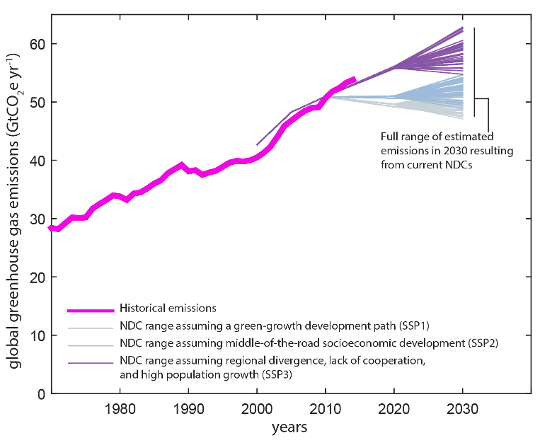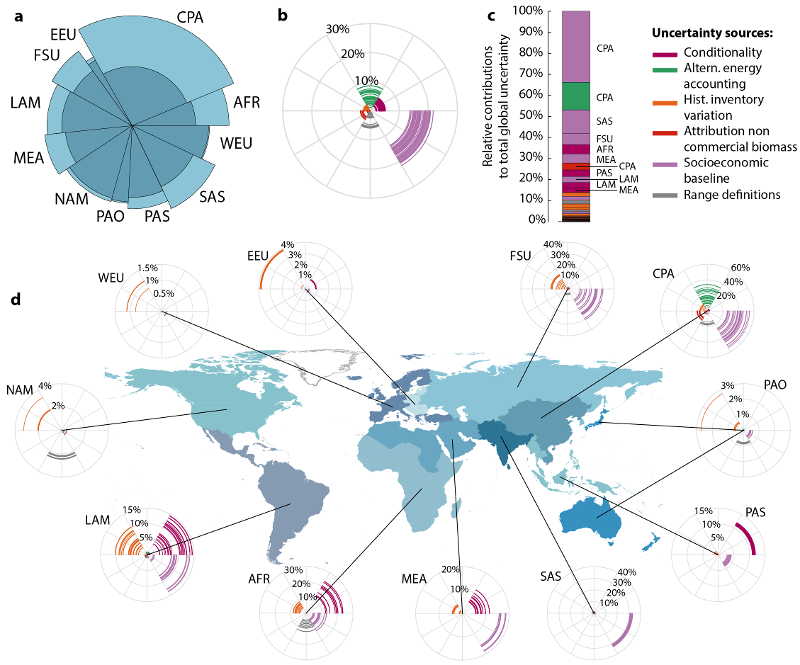
Policy Brief #23, June 2019. IIASA research has found explanations for variations in estimates of global greenhouse gas emissions by 2030. According to the researchers, actions set out in countries’ nationally determined contributions are described ambiguously, introducing uncertainty into the stocktaking process. This poses a danger that action plans will not be strengthened sufficiently to avoid dangerous levels of climate change.
- As part of the Paris Agreement countries put forward pledges known as nationally determined contributions (NDCs) whose impact is assessed in regular global stocktaking exercises allowing actions towards climate objectives to be strengthened.
- The research shows that uncertainty in how NDCs are described results in projected emissions for the year 2030 varying between -10% and +20% around the median - and that this has critical implications for the feasibility and cost of limiting global warming to well below 2°C and further to 1.5°C.
- Policymakers should decide on common, best standard and internally consistent emission inventories.
- Conditions attached to action plans should be clear and transparency is required about what support will be made available to achieve them.
- A decision should be made on whether to include non-commercial or traditional biomass use in renewable energy and the method by which renewables are compared to other energy sources.
- These measures would reduce the overall uncertainty range by about 10 percentage points. However, tackling the greater part of emissions projection uncertainty depends on policy choices.
- This will require clear communication around how emissions projections will be achieved.
- Clarity about the assumed socioeconomic development that underlines policy projections, and/or expressing NDCs as reductions relative to a historical reference year.
A commitment to climate mitigation
The UN Paris Agreement includes a legally binding mechanism to increase climate mitigation action over time. Countries put forward pledges known as nationally determined contributions (NDCs) whose impact is assessed in regular global stock taking exercises. This allows actions towards climate objectives to be strengthened. However, the actions set out in the NDCs are described ambiguously which introduces uncertainty into the stocktaking process and presents a danger that action plans will not be strengthened sufficiently to avoid dangerous levels of climate change.
The table shows how potential contributors affect uncertainty in projections of global greenhouse gas emissions for the year 2030.
 © IIASA
© IIASA
The uncertainty issue
The current ambiguity in NDCs is a critical issue for the global stocktake. Depending on the interpretation of these action plans, the IIASA research shows that emissions could either continue to increase, stabilize, or decrease by 2030.
 © Figure reproduced from Rogelj et al., Nature Communications (2017). Interpretations of the various “SSP” scenarios are provided in Riahi et al. (2018).
© Figure reproduced from Rogelj et al., Nature Communications (2017). Interpretations of the various “SSP” scenarios are provided in Riahi et al. (2018).
Range of 2030 emissions resulting from various interpretations of the current NDCs. Global historical emissions and projected emissions under the current NDCs.
The Paris Agreement however aims for emissions to peak as soon as possible. Even with the great uncertainty about the effect of climate change mitigation plans the world is definitely not on track to limit warming to below 2°C, let alone 1.5°C. Unless policymakers strengthen their nationally defined contributions to reduce uncertainties the choices to be made beyond 2030 become starkly unpalatable. For example, a sudden increase in carbon prices in 2030 (by a factor of about four) is to be anticipated and the window on limiting warming to 1.5°C would close.
 © Figure reproduced from Rogelj et al., Nature Communications (2017).
© Figure reproduced from Rogelj et al., Nature Communications (2017).
Regional contributions to overall NDC emission projection uncertainty. (a) Regional emissions contributions to global emissions and uncertainty under the full implementation of current NDCs. Shadings show the minimum–maximum range of emissions estimates p
What can be done to reduce uncertainty?
Some variation can easily be removed from emissions targets by technical clarifications but others depend on government policy choices and assumptions for which there is no simple technical fix. IIASA researchers studied the actions pledged by each country to reduce greenhouse gas emissions. From six potential contributors several were identified that contribute significantly to overall uncertainty around reaching the targets of the Paris Agreement.
- Variations in the socioeconomic baseline: This is the dominant driver of global emissions uncertainty and involves assumptions around future socioeconomic development. Uncertainty can occur when a country specifies actions in terms of emission intensity improvements, that is, emissions per unit of GDP, or relative to an unspecified hypothetical baseline. Emissions in 2030 will consequently be higher or lower, depending on socioeconomic development.
- Variations in historical emission inventories: Many national action plans contain emission targets relative to a historical reference year, for example, 1990 or 2005. If the level of emissions in this year is uncertain, emission projections will be uncertain.
- Conditionality of actions: Some countries NDCs come with conditions attached, for example they might be subject to the availability of finance. Not knowing whether these conditions will be met adds to uncertainty.
- Range specifications: Instead of providing a single number, some countries provide a range of potential emissions reductions in their NDCs.
- Alternative energy accounting methods: The emissions contributions of renewable and fossil energy sources can be compared by expressing renewable energies in ‘primary energy equivalence’. Because several conversion methods exist, this influences emission estimates if NDCs target a specific share of renewables in the energy mix.
- Attribution of non-commercial biomass: Non-commercial biomass, sometimes referred to as traditional biomass, represents an important share of the overall energy demand in some developing regions. If this non-commercial biomass is counted towards renewable energies it can influence the ease with which a country achieves a specific share of renewables in the energy mix.
IIASA Policy Briefs present the latest research for policymakers from IIASA - an international, interdisciplinary research institute with National Member Organizations (NMOs) in countries in Africa, the Americas, Asia, and Europe. The views expressed herein are those of the researchers and not necessarily those of IIASA or its NMOs.
